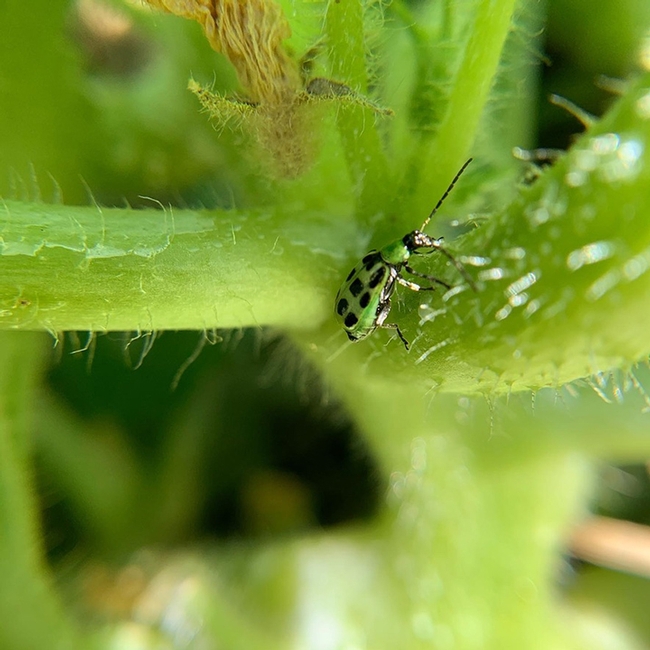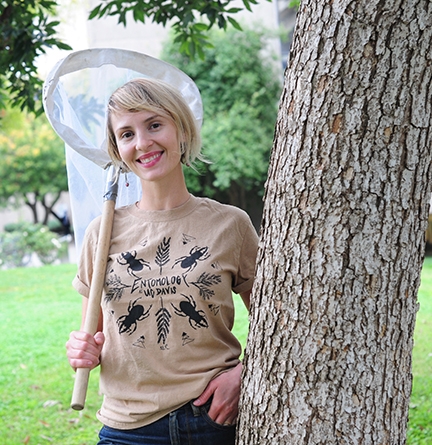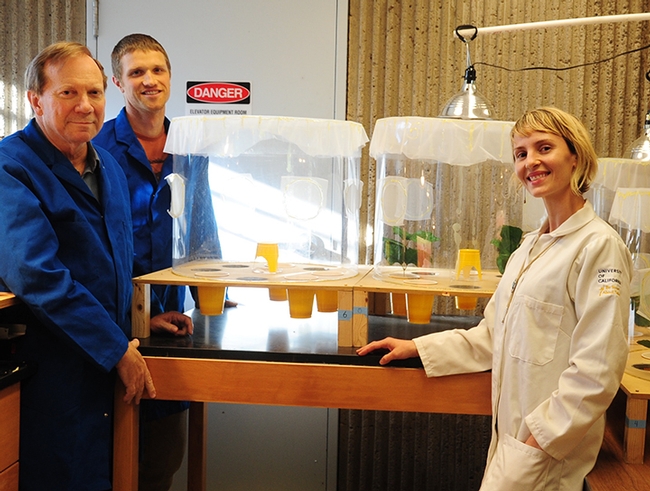- Author: Kathy Keatley Garvey

The schedule:
Oct. 7
Myfany Turpin, Ph.D
University of Sydney, Sydney Conservatorium of Music
Title: Grub's Up! The Category of Edible Insect Larvae in Central Australian Aboriginal Languages
Website link
Hosts: Scott Carroll and Jenella Loye
Oct. 14
Amanda Koltz, Ph.D
Washington University, Department of Biology
Title: Species Interactions and Ecosystems in a Changing World
Website link
Host: Emily Meineke
Oct. 21
Maria Onyango, Ph.D
New York State Department of Health, Wadsworth Centre
Title: The Impact of Zika Virus Infection on the Metabolites and Microbiome of Aedes albopictus
Website link
Host: Geoffrey Attardo
Oct. 28
Anjel Helms, Ph.D
Texas A&M University, Department of Entomology
Title: The Smells of Dinner, Death, and Danger: How Organisms Navigate Multitrophic Interactions in a Chemical World
Website link
Host: Ian Grettenberger
Nov. 4
Xianhui (Nitrol) Liu, Ph.D
UC Davis Department of Entomology and Nematology
Title: How Does the Time of Eating Affect our Circadian Physiology? (exit seminar)
Website link
Host: Joanna Chiu
Dec. 2
Peter DiGennaro, Ph.D
University of Florida, Entomology and Nematology Department
Title: Gaps in Molecular Plant Nematology
Website link
Host: Shahid Siddique
Dec. 9
Andre Kessler, Ph.D
Title: Chemical Information Driving Plant Interactions and Community Dynamics
Website link
Host: Rick Karban
For more information or for technical issues, contact Grettenberger at imgrettenberger@ucdavis.edu
- Author: Kathy Keatley Garvey

But if you're Jasmin Ramirez Bonilla, a UC Davis graduate student in entomology, you're seeking to control these agricultural pests through more effective integrated pest management (IPM) strategies.
Jasmin, who plans to complete her master's degree in the spring of 2022, recently presented her thesis proposal, “Advancing Integrated Pest Management Strategies for Cucumber Beetles in California,” to the UC Davis Department of Entomology and Nematology at a Zoom session.
“The beetle of focus for my thesis is the Western striped cucumber beetle, Acalymma trivittatum,” said Jasmin, who studies with major professor and agricultural entomologist Ian Grettenberger, a Cooperative Extension specialist in the UC Davis Department of Entomology and Nematology. “A second species, the Western spotted cucumber beetle, Diabrotica undecimpunctata undecimpunctata--a milder pest but still a pest of melons-- is also part of my project but not the primary subject of my studies.”
Her thesis project consists of three objectives:
- Characterize the non-crop and overwintering habitat
- Clarify short-distance dispersal dynamics after harvest
- Evaluate the utility of the aggregation pheromone, vittatalactone
Both species feed on muskmelons, Cucumis melo. “These include honeydew melon, cantaloupe, crenshaw, and cassava,” she said. “However, Acalymma is the specialist.” Cucumber beetles are pests of plants in the Cucurbitaceae family,which includes melons, gourds, cucumbers, squash and pumpkin.
Of key concern is “the lack of effective IPM tools for the management of cucumber beetles, especially the western striped cucumber beetle,” she said. “There is a critical need to visit this system and revisit the ecology to have a clearer understanding of the non-crop habitat uses and dispersal dynamics to improve and optimize the scouting and monitoring strategies. In addition, one way to monitor and manage insect pests is using semiochemicals such as aggregation pheromones and kairomones—for example, cucurbit blossom volatiles--which are of interest to be combined and studied their efficacy attraction.”
Preliminary data for one of her experiments indicates that the synthetic aggregation pheromone, vittatalactone, attracts the western striped cucumber beetle and the spotted cucumber beetle. “This pheromone was mimicked from airborne volatiles produced by male beetles, Acalymma vittatum, the cousin of the western striped cucumber beetle,” Bonila related. “This pheromone is a potential monitoring tool for managing these beetles and minimize the intensive applications of insecticides on the field.”
What sparked her interest in entomology? When she worked as a field research assistant for six months in 2017 with the UC Cooperative Extension in Woodland and sampled Lygus damage in sunflower fields.
“After this field assistant position, I worked as a junior specialist on an alfalfa weevil project to improve management in alfalfa,” Jasmin related. This was a research grant of the late Larry Godfrey (1956-2017), an Extension entomologist based in the UC Davis Department of Entomology and Nematology. Godfrey, the principal investigator of the grant, worked with co-principal investigator Yolo County Farm Advisor Rachael Long until his death in April.
Long invited Jasmin to apply for the position. “That increased my interest in bugs,” Jasmin said. “There were so many different species and I was constantly collecting plethora of insects in each sample!”
A native of Guatemala, Jasmin moved to the United States at age 15 with her family. “Even though I wasn't born here, I still consider myself Guatemalan,” she related. “My family lives in Los Angeles and I attended Reseda High School in the San Fernando Valley.”
Jasmin, who received her bachelor's degree in earth system science at UC Merced in 2016, worked as a vegetation and ecological restoration intern with the National Park Service before enrolled in the UC Davis graduate program.
But it's the insects—particularly cucumber beetles—that fascinate her.


- Author: Kathy Keatley Garvey

Grettenberger, who fills the vacated position of Larry Godfrey (1956-2007), received his bachelor of science degree in biology, with an ecology, evolution and organismal emphasis (honors Program) in 2009 from Western Washington University, Bellingham, Wash., and his doctorate in entomology in 2015 from Pennsylvania State University, State College, Pa. He served as a postdoctoral researcher in the Godfrey lab and later, the Frank Zalom lab, before accepting his current appointment of assistant Cooperative Extension specialist.
Grettenberger's fields of expertise include field and vegetable crops; integrated pest management; applied insect ecology, and biological control of pests.
He targets a wide variety of pests, including western spotted and striped cucumber, beetles, armyworms, bagrada bugs, alfalfa weevils, aphids, and thrips.
Among his current grants:
- Protection of rice from invertebrate pests
- Management of key cotton arthropod pests with insecticides and acaricides, a proactive approach to prepare for the invasion of the tomato leafminer (Tuta absoluta) into California
- Detection, biology and control of the exotic Swede midge (Contarinia nasturtii) for California cole crops
- Management of the western spotted and striped cucumber beetle in melon production
- Biological control of the bagrada bug
- Insecticide resistant alfalfa weevils in the western United States:Quantifying the scope of resistance and implementing a plan to manage the threat
- Insecticide resistance monitoring and evaluation of efficacy of current chemical tactics for managing aphids and thrips in lettuce
How did you get interested in entomology? Can you recall an occasion that sparked your interest?
I had biologist parents, and was drawn into entomology at a pretty young age. I spent plenty of time looking in flowers and turning over logs looking for insects. Once I started thinking about going to graduate school for entomology, I decided to focus on the intersection of agricultural entomology and insect ecology. I wanted to work on applied issues in entomology.
How would you describe yourself?
I like tackling problems, which has worked out well with my work in applied entomology and extension. I can be intensely focused and immensely distracted, which I would say has its pluses and minuses.
What do you like best about your work?
I love working in applied entomology and that I get to use research to better understand pests and work to develop IPM tools. The breadth of crops I cover is both a bit overwhelming but immensely exciting because of the diversity in pest issues, types of tactics that are applicable, and interesting ecological/biological questions among the various crop pests. I also get to work with great people, both within my lab and with all of the various collaborators/cooperators. I have met and worked with a lot of fantastic people this first year, and I also think my lab is off to a great start.
Where were you born and where did you spend your childhood?
I was born in Portland, Ore., but I primarily grew up in Olympia, Wash. As you might imagine, I grew up with lots of rain, but in a beautiful area.
What are your research plans/goals here at UC Davis? What drew you to UC Davis?
Thus far, I have been focused on projects in crops where there has historically seen solid research by UC Davis (such as rice and cotton) and have been developing new projects and collaborations. For better or worse, IPM is never static, so my research will be continually evolving to address pest management needs and has already been shifting this first year. Because I have an extension appointment, stakeholder needs have driven much of my work and this will continue to be a theme.
I was drawn to Davis by the many opportunities it would afford working in agricultural entomology. The department has a great reputation academically and the people in it are great as well. I also would have (and have had) the opportunity to connect with many other great researchers in the UC system, both campus- and county-based. There are many crops and pests to work on. We are quite literally surrounded by crops I work in, including alfalfa, rice, and tomatoes. I even found some alfalfa weevil on my run last weekend.
What do you like to do in your leisure time?
My primary hobby is running, ideally on trails and long distances. I can deal with the nearly zero elevation gain in our area, but I like to get out to where there are some hills. I also like to be outdoors in general and spending time with my family (wife/dog/cat; dog will go on adventure runs with us, cat only gets the backyard).
What would people be surprised to know about you?
I don't like all foods, but I will try basically anything just to see what it tastes like. I think some people are also surprised by the amount of food I can eat at one time.


- Author: Kathy Keatley Garvey

The grants, announced Dec. 13, total $1.1 million.
Grettenberger and his UC Davis research collaborators will receive $499,847 for “A Proactive Approach to Prepare for the Invasion of Tuta absoluta into California.” T. absoluta, a tomato leafminer, is a serious pest throughout Europe, Africa, western Asia and South and Central America and could decimate California's tomato industry, a CDFA spokesman said. “This project will proactively test targeted insecticides, identify native natural enemies that could be used in biological control, and conduct work to assist in breeding plants resistant to this pest. This project will be conducted at UC Davis, throughout California, and in Chile and Peru."
Grettenberger and co-project leaders Alejandro Del Pozo-Valdivia and Daniel Hasegawa of the UC Davis Division of Agriculture and Natural Resources (UC ANR), will receive $261,543 for “Detection, Biology and control of the Exotic Swede Midge (Contarinia nasturtii) for California Cole Crops.” Swede midge, a pest of cole crops in the Northeastern U.S. and Canada, could cause significant management issues for California's large cole crop industry, a CDFA spokesperson said. “This project will collect important information about the biology of Swede midge, test low impact insecticides and botanical products as options for control, assess the possibility of weeds as alternative hosts, and work with growers to start monitoring for the pest. This project will be conducted mainly at UC Davis and in the Salinas Valley.”
The third CDFA grant of $348,893 went to project leaders Mark Hoddle and Jocelyn Millar of UC Riverside for “Proactive Management of Avocado Seed and Stem Feeding Weevils, Heilipus spp. (Coleoptera: Curculionidae: Molytinae).” This project will develop pheromones, identify natural enemies in the host range, and quantify flight capacity of the avocado seed weevils, a CDFA spokesperson said. The weevils, native to Mexico and invasive in Ecuador, feed directly on avocados and could cause substantial damage to the California avocado industry, a CDFA spokesman said. "The California Avocado Commission pledged an additional $150,000 to support this project, a testament to their concern over this pest. The work will be conducted mainly at UC Riverside and in Mexico. “
Each project received strong support from commodities that could be affected by invasive pests. A review committee, of scientists from the U.S. Department of Agriculture, University of California, state government and private pest control advisors, scored the proposals and recommended the recipients.
CDFA is responsible for preventing and mitigating invasive pests in California.
- The Proactive IPM Solutions grants program targets exotic pests likely to arrive in California. It aims to identify and test IPM strategies that can be rapidly implemented if the pests become established in California.
- OPCA, created to provide consultation to the California Department of Pesticide Regulation (DPR), focuses on potential pesticide regulatory impacts and pest management alternatives that may mitigate or prevent such impacts on production agriculture.
Grettenberger, who joined the UC Davis faculty earlier this year, replaces the late Larry Godfrey, who died of cancer April 18, 2017. Grettenberger holds a bachelor of science degree from Western Washington University and a doctorate from Pennsylvania State University. His areas of expertise include field and vegetable crops; insects, mites and other arthropods affecting plants; biological control of pests affecting plants; and beneficial insects.
- Author: Kathy Keatley Garvey

“My art is inspired by the harmony between nature and insects,” said Rice, a junior specialist in the Larry Godfrey lab, UC Davis Department of Entomology and Nematology. She studies the bagrada bug with postdoctoral fellow Ian Grettenberger.
“I am truly humbled by the complexity and beauty of many of them!” Rice said. “I'm captivated by insects' structural biology, ability to evolve over time and the intricate ways in which they communicate.”
The stag beetle t-shirt design not only incorporates her love for stag beetles (family Lucanidae) but illustrates the “geometric patterns that are hidden in the deciduous forests they dwell in,” said Rice, who enjoys fuses art with science..
Stag beetles are so named because of the males' unique mandibles, often compared to deer antlers. The beetles are ground-dwellers but also can fly. Some males measure 7 centimeters in length or just under three inches, while the adult females are about 5 centimeters long.
Her winning t-shirt last year depicted a wasp riding a penny-farthing or a high wheel bicycle. Both t-shirts and scores of other winning t-shirts are available for sale on the EGA website, https://mkt.com/UCDavisEntGrad
A native of Roseville, Rice received her bachelor's degree in biological sciences with a minor in medical-veterinary entomology in March 2015. Her career goal, to become a professional research entomologist, stems from her childhood interest in the biological sciences.
“This is a continuation of my experience as a researcher, teachers assistant, and mentor,” she said. “With the support of Dr. Larry Godfrey (Extension entomology, UC Davis Department of Entomology and Nematology), I have been motivated to pursue my Ph.D. I'm grateful for his commitment to fostering my intellectual growth, and dedication to mentoring a young woman scientist in a field where women are frequently underrepresented.”
“I'm particularly interested in integrated pest management practices that could have real world impact,” Rice said. “By understanding the biology and behaviors of pest insects, as well as their interaction with other organisms, the reliance on heavy pesticide use in agriculture may become minimized and more targeted. “
Her work in the Godfrey lab in collaboration with Ian Grettenberger, postdoctoral Research Associate, involves investigating the biology and behavioral ecology of the bagrada bug, Bagrada hilaris, an invasive species from Africa. The now widespread stink bug attacks cole crops, including broccoli, cabbage, collards, arugula, cauliflower, kale, and mustard.
“Dr. Grettenberger has taught me how to manage time and stay organized in order to execute an effective research plan,” Rice said, “and I am inspired by his enthusiasm to solve problems.”\
Rice hopes to start graduate school in autumn of 2017. Meanwhile, she continues to share her fascination for insects with friends, family and the Davis community.
For several years, Rice was an active member of the UC Davis Entomology Club, advised by forensic entomologist Robert Kimsey of the UC Davis Department of Entomology and Nematology faculty. “I consider Bob Kimsey as my mentor and friend. Along with the various projects of the entomology club, he has instilled in me a deep curiosity of the natural world and a strong desire to give back to the community as an entomologist.”
Rice's award-winning t-shirt went on sale at the Entomological Society of America/International Congress of Entomology meeting, held in early November in Orlando, Fla.
Cindy Preto of the Frank Zalom lab is coordinating the sale of the t-shirts. All proceeds benefit EGSA.



